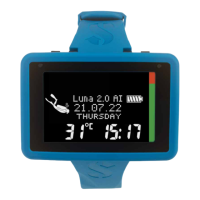66
LUNA 2.0 AI USER MANUAL
3 .17 .3 Prohibited altitude
Going to altitude, as well as ying after diving, exposes your body to reduced ambient pressure. In a manner similar
to no-y time, the LUNA 2.0 AI advises you of the safe altitudes you can reach after a dive, and those which are not
safe. If you have to drive over a mountain pass to return home after a dive, this information can be quite important,
and you can check this information in the dive planner.
The current altitude class is shown in the middle on the bottom row and the prohibited altitude is shown on the right.
In the example above, the diver is presently at altitude class 0 and should not reach altitudes above 4000m (class
4) within the given surface interval of thirty minutes. By increasing the interval time on the middle row, the allowed
altitude increases due to the desaturation caused by the time spent at the current altitude class.
WARNING
If atmospheric pressure is below 610mbar (altitude higher than 4000m/13300ft), no decompression calculation is carried out
by the LUNA 2.0 AI, and it will not start in SCUBA mode, but in GAUGE mode. In addition, the dive planner is not available at this
altitude.
3 .17 .4 Decompression dives in mountain lakes
In order to ensure optimal decompression even at higher altitudes, the 3m/10ft decompression stage is divided into
a 2m/7ft stage and a 4m/13ft stage in altitude ranges 1, 2 and 3.
If atmospheric pressure is below 610mbar (altitude higher than 4000m/13300ft), no decompression calculation is
carried out by the LUNA 2.0 AI (automatic GAUGE mode). In addition, the dive planner is not available in this altitude
class.
3 .18 Diving with Nitrox
Nitrox is the term used to describe breathing gases made of oxygen-nitrogen mixes with oxygen percentages
higher than 21% (air). Because nitrox contains less nitrogen than air, there is less nitrogen loading on the diver’s
body at the same depth as compared to breathing air.
However, the increase in oxygen concentration in nitrox implies an increase in oxygen partial pressure in the
breathing mix at the same depth. At higher than atmospheric partial pressures, oxygen can have toxic effects on
the human body. These can be grouped into 2 categories:
1. Sudden effects due to oxygen partial pressure over 1.4bar. These are not related to the length of the exposure
to high oxygen partial pressure. Sudden effects can vary and depend on the exact level of partial pressure
they happen at. It is commonly accepted that partial pressures up to 1.4bar are tolerable during the active part
of the dive, and maximum oxygen partial pressures up to 1.6bar during the decompression.
2. Long exposure effects due to oxygen partial pressures over 0.5bar due to repeated and/or long dives. These
can affect the central nervous system and cause damage to lungs or to other vital organs. Long exposures
can be divided between more severe Central Nervous System effects and less dangerous long-term
Pulmonary Toxicity effects. The LUNA 2.0 AI treats high ppO
2
and long exposure effects in the following ways:
Against sudden effects: The LUNA 2.0 AI has an MOD alarm set for a user-dened ppO
2
max. As you enter the
oxygen concentration for the dive, the LUNA 2.0 AI shows you the corresponding MOD for the dened ppO
2
max.
The default value of ppO
2
max from the factory is 1.4bar. This can be adjusted to your preference between 1.0 and
1.6bar. It can also be turned off. Please refer to chapter Setting gas oxygen content for more information on how
to change this setting.
Against long exposure effects: The LUNA 2.0 AI “tracks” the exposure by means of the CNS O
2
clock. At levels
of 100% and higher there is risk of long exposure effects, and consequently the LUNA 2.0 AI will activate an alarm
when this level of CNS O
2
is reached. The LUNA 2.0 AI can also warn you when the CNS O
2
level reaches 75%.

